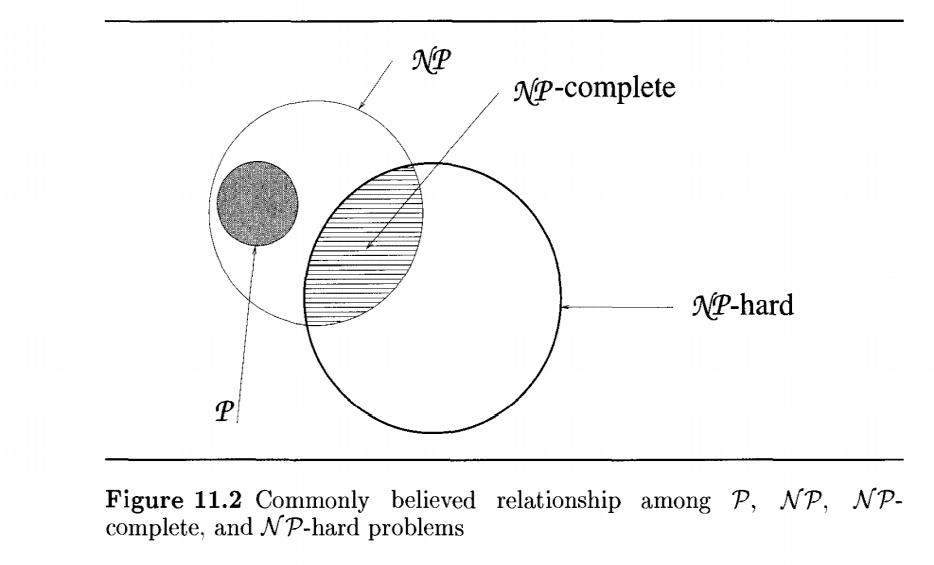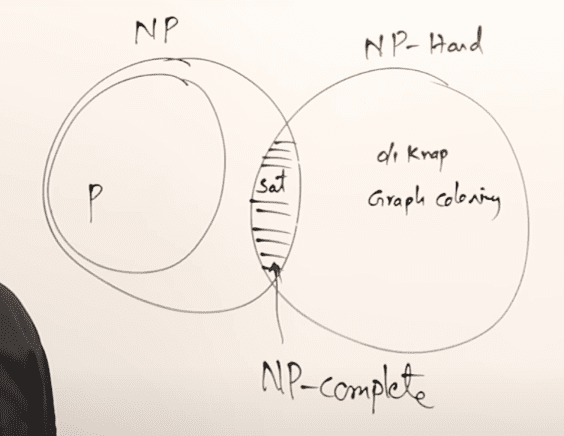09 NP
Problems¶

| P | NP | NP Complete | NP Hard | |
|---|---|---|---|---|
| Can be solved using __ algorithm | Deterministic | Non-Deterministic | Non-Deterministic | Non-Deterministic |
| Time Complexity (Solving) | Polynomial | Exponential | Exponential | Exponential |
| Time Complexity (Verification) | Polynomial | Polynomial | Exponential | |
| Type of problem | Any | Any | Decision Problem | Any |
| IDK | Problem L is NP Complete if - L is in NP - Every problem in NP is reducible to L in polynomial time | |||
| Example | Determination of hamiltonian cycle Determination of satisfaction level of boolean formula | Circuit Satisfactory Vertex Cover Halting problems |

Problem Properties¶
Reducible¶
\(L_1 \underset{\text{reduces to}}{\propto} L_2 \iff\) there is a way to solve \(L_1\) using a deterministic algorithm that solves \(L_2\) in polynomial time
This is transitive, ie, \(L_1 \propto L_2, L_2 \propto L_3 \implies L_1 \propto L_3\)
Polynomially-Equivalent¶
\(L_1\) and \(L_2\) are polynomially-equivalent \(\iff (L_1 \propto L_2) \land (L_2 \propto L_1)\)
To show that a problem \(L_2\) is NP-Hard, it is sufficient to show that \(L_1 \propto L_2\), where \(L_1\) is a problem already known to be NP-Hard.
Due to transitivity, if satisfiability \(\propto L_1\) and \(L_1 \propto L_2 \implies\) Satisfiability \(\propto L_2\)
To show that an NP-Hard decision problem is NP-Complete, we just need to find a polynomial time non-deterministic algorithm for it.
P & NP Algorithms¶
| P Algorithm | NP Algorithm |
|---|---|
| Deterministic | Non-Deterministic |
| Polynomial | Polynomial |
| Used to solve exponential problems |
Non-Deterministic Algorithms¶
choice(S) | Arbitrarily choose one of the elements in set \(S\) |
failure() | Signals unsuccessful completion |
success() | Signals successful completion |
Non-Deterministic Search Algorithm¶
Non-Deterministic Sort of +ve integers¶
Algo Nsort(a, n)
for i=1 to n
b[i] = 0
// randomly place elements
for i=1 to n
c = choice([1, n])
if b[c] != 0 // element already not there
b[c] = a[i]
else // element exists at same position
failure()
// verify order
for i=1 to n
if b[i] > b[i+1]
failure()
sucess()
Non-Deterministic Binary Knapsack¶
Algo NDBK(profits, weights, min_profit, max_weight)
taken_profit = 0
taken_weight = 0
for i=1 to n do
c = choice(0, 1)
if c == 1 then
taken_profit += profits[i]
taken_weight += weights[i]
if (
(taken_profit >= min_profit) &&
(taken_weight <= max_weight)
)
success()
else
failure()
Clique Problem¶
A clique is complete subgraph of a given graph, ie, every node of the subgraph is connected to each other.
Algo clique(a) // adjacency matrix
s = [] // subgraph
// randomly add elements
for i=1 to a.length
c = choice(0, 1)
if c==1
s.add(
(i, j)
)
// verify subgraph
for i=1 to a.length
for j=1 to a.length
i not connected to j then
failure()
success()
Satisfiability¶
Algo sat(E, n)
for i=1 to n do
x[i] = choice(false, true)
if E(x[1], ..., x[n]) then
success()
else
failure()
NP-Hard Graph Problems¶
To prove that a problem \(L_2\) is NP-hard
- Pick a problem \(L_1\) already known to be NP-hard
- Show how to obtain (in polynomial deterministic time) an instance \(I'\) of \(L_2\) from any instance \(I\) of \(L_1\) such that from the solution of \(I'\), we can determine (in polynomial deterministic time) the solution to instance \(I\) of \(L_1\)
- Conclude from 2. that \(L_1 \propto L_2\)
- Conclude from 1 & 3 and transitivity that \(L_2\) is NP-hard